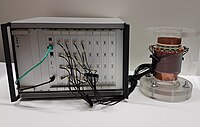Process tomography

Imagine you have a big box filled with lots of little balls. You can't see inside the box, but you want to know where all the balls are and how they're moving around. Process tomography is like having a special X-ray machine that takes pictures of the inside of the box and helps you understand what's going on in there.
But instead of balls in a box, process tomography is used to study things like liquids, gases, and other materials inside pipes or tanks. Scientists and engineers use process tomography to understand how these materials are flowing, mixing, and reacting. They do this by sending tiny signals through the material, like electrical or magnetic waves, and watching how they change as they pass through. This helps them create a picture of what's happening inside the pipe or tank, kind of like a movie of the material's behavior.
By using process tomography, scientists and engineers can better understand how to control and optimize processes, like making chemicals or refining oil. It's kind of like having a secret camera inside the box that helps you figure out how to make the balls move just the way you want them to.
But instead of balls in a box, process tomography is used to study things like liquids, gases, and other materials inside pipes or tanks. Scientists and engineers use process tomography to understand how these materials are flowing, mixing, and reacting. They do this by sending tiny signals through the material, like electrical or magnetic waves, and watching how they change as they pass through. This helps them create a picture of what's happening inside the pipe or tank, kind of like a movie of the material's behavior.
By using process tomography, scientists and engineers can better understand how to control and optimize processes, like making chemicals or refining oil. It's kind of like having a secret camera inside the box that helps you figure out how to make the balls move just the way you want them to.
Related topics others have asked about:
